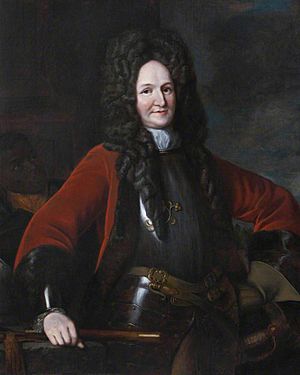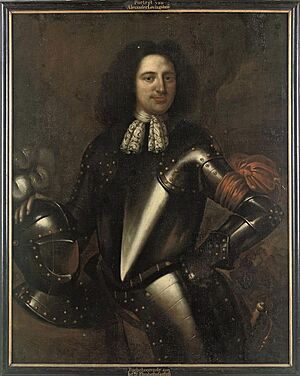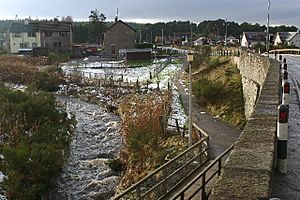Thomas Livingstone, 1st Viscount Teviot facts for kids
Quick facts for kids
Sir Thomas Livingstone, Viscount Teviot
|
|
|---|---|

Sir Thomas Livingstone, PC
|
|
| Commander-in-Chief, Scotland | |
| In office 1690–1696 |
|
| Privy Council of Scotland | |
| In office 1690–1707 |
|
| Personal details | |
| Born | 1651 Dutch Republic |
| Died | 14 January 1711 (aged 59–60) London England |
| Military service | |
| Years of service | 1668 (?)– 1704 |
| Rank | Lieutenant-General |
| Unit | Royal Scots Greys |
| Battles/wars |
|
Sir Thomas Livingstone, Viscount Teviot (born around 1651 – died January 14, 1711) was a brave military officer. He was from a Scottish family but was born in the Dutch Republic. He spent his whole career working for William of Orange, who later became King of England.
After the Glorious Revolution in 1688, he helped Hugh Mackay during the Jacobite rising of 1689 in Scotland. This was a time when supporters of the old king, James II, fought against the new king, William. In November 1690, Thomas Livingstone took over from Mackay as the main commander in Scotland. He held this important job until 1696, just before a big war called the Nine Years' War ended in 1697.
He became a Lieutenant-General in 1703. He stopped his military service in 1704 and passed away in London on January 14, 1711.
Contents
Early Life and Family
Thomas Livingstone was born in the Dutch Republic in 1651. His father, also named Sir Thomas Livingstone, was from a place called Newbigging, South Lanarkshire in Scotland. In 1635, his father joined the Scots Brigade. This was a group of Scottish soldiers who worked for the Dutch army. His father married Gertrat Edmond, whose family was also Scottish but lived abroad. Thomas had one younger brother named Alexander.
Thomas Livingstone married Macktellina Walrave de Nimmeguen. They did not have any children. He died in London in 1711. He left most of his money and property to his younger brother, Alexander. The special title of Viscount Teviot ended when Thomas passed away because he had no children to inherit it.
Military Career and Key Battles

In the past, there were strong feelings against having large armies in Scotland and England. This meant that many people who wanted to be soldiers had to join armies in other countries. These soldiers were a small, skilled group of professionals. During the Jacobite rising of 1689, many of the commanders, including Livingstone, his leader Hugh Mackay, and even some of their opponents, had all served together in the Scots Brigade.
Thomas Livingstone, his father, and his brother Alexander were officers in one of the Scottish regiments in the Brigade. When his father died in 1673, Thomas took over his military position and his special title. The Brigade fought in the Franco-Dutch War from 1672 to 1678. Thomas was wounded at the Battle of Cassel in 1677. He also fought in the Battle of Saint-Denis in 1678, just before the war ended.
Joining King William III
In 1684, Livingstone became a Lieutenant-Colonel. He went with William III when William came to England in November 1688. This event was known as the Glorious Revolution. The old king, James II, left the country after his army stopped supporting him. Livingstone then became the Colonel of a dragoon regiment, which was a type of cavalry unit.
Fighting in Scotland
Livingstone joined Mackay in Scotland in April 1689 during the Jacobite Rising. As cavalry, their job was to keep the roads safe between Inverness and Stirling. Because of this, they missed the Jacobite victory at the Battle of Killiecrankie in July. Even with this setback, Mackay and Livingstone slowly gained control. In 1690, they led separate forces in a planned attack. This led to Livingstone's victory at the Battle of Cromdale in May. They even wrote letters to each other in Dutch, probably so that Jacobite forces couldn't understand them if they were captured.
Commander-in-Chief and Later Years
Livingstone took over from Mackay as the main commander in Scotland on November 10, 1690. He also became a member of the Privy Council of Scotland, a group of advisors to the king. For the next 18 months, he worked to take control of Jacobite strongholds and secure the Scottish Highlands. One of his last actions in this role was the Massacre of Glencoe in February 1692. While the event was controversial, Livingstone was later cleared of any wrongdoing by an investigation.
Livingstone stayed in Scotland for most of the Nine Years' War (1688-1697). In December 1696, Livingstone was given the special titles of Viscount Teviot and Lord Livingstone of Peebles. He was promoted to Major General and took charge of a Brigade in the Netherlands. This was just before the Treaty of Ryswick ended the war in 1697. He became a Lieutenant-General in 1703, but this was the end of his active military service. He did not take part in the War of the Spanish Succession. He sold his position as Colonel in 1704.
Livingstone spent most of his later life in Wimbledon, which was a suburb of London at the time. He died there on January 14, 1711. He was buried in Westminster Abbey, a very famous church in London. His brother Alexander paid for a beautiful memorial there, which you can still see today.
He wrote an account of the Battle of Cromdale in May 1690. He also published a guide for soldiers called Exercise of the Foot.
Publications
- Account of Cromdale (May 1690)
- Exercise of the Foot, with the evolution according to the words of command etc etc; (a drill guide)
| Military offices
|
||
|---|---|---|
| Preceded by Lord Charles Murray |
Colonel of the Royal Scots Greys 1689–1704 |
Succeeded by Lord John Hay |
| Preceded by Hugh Mackay |
Commander-in-Chief, Scotland November 1690–1696 |
Succeeded by ???? |



